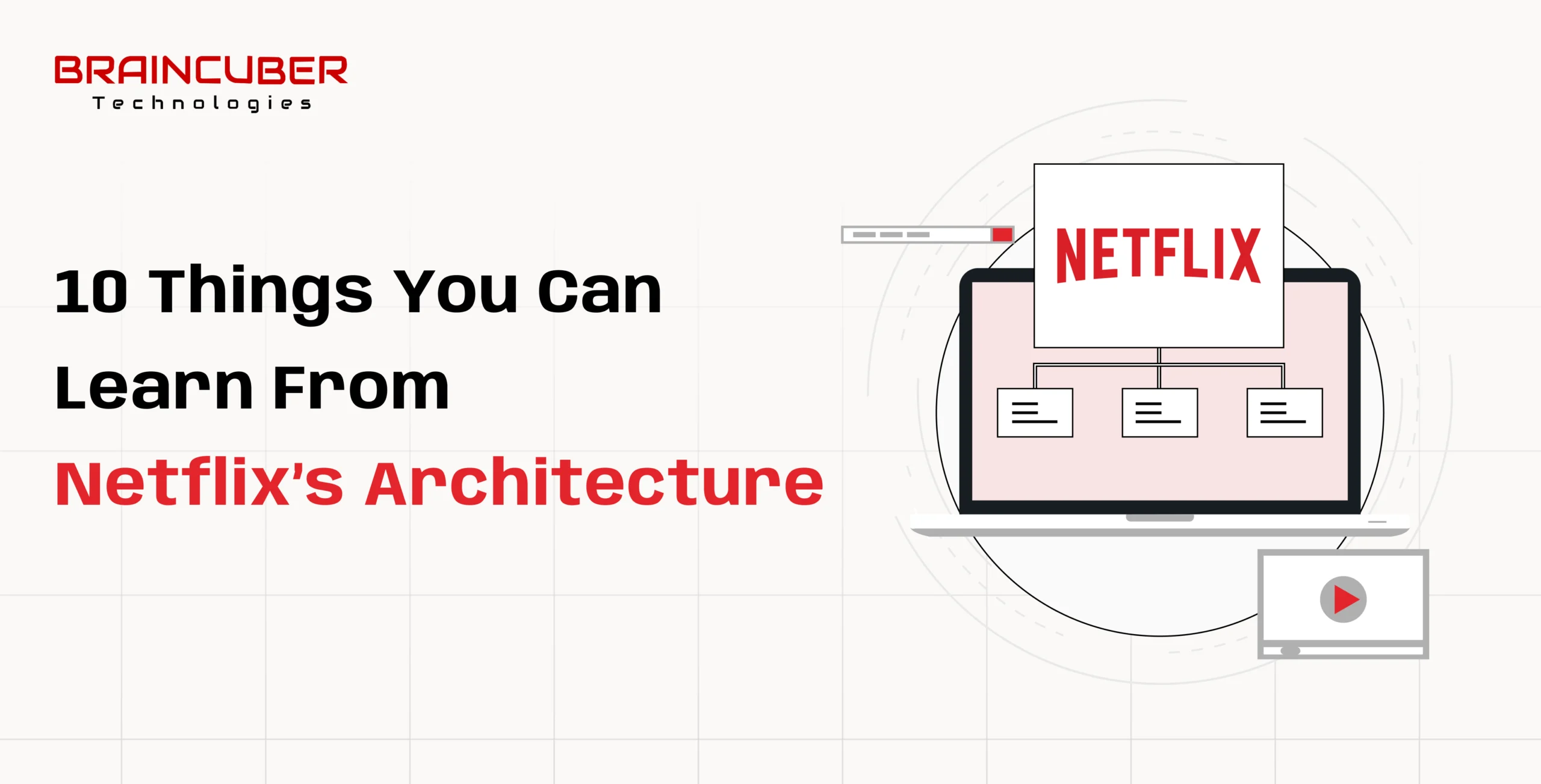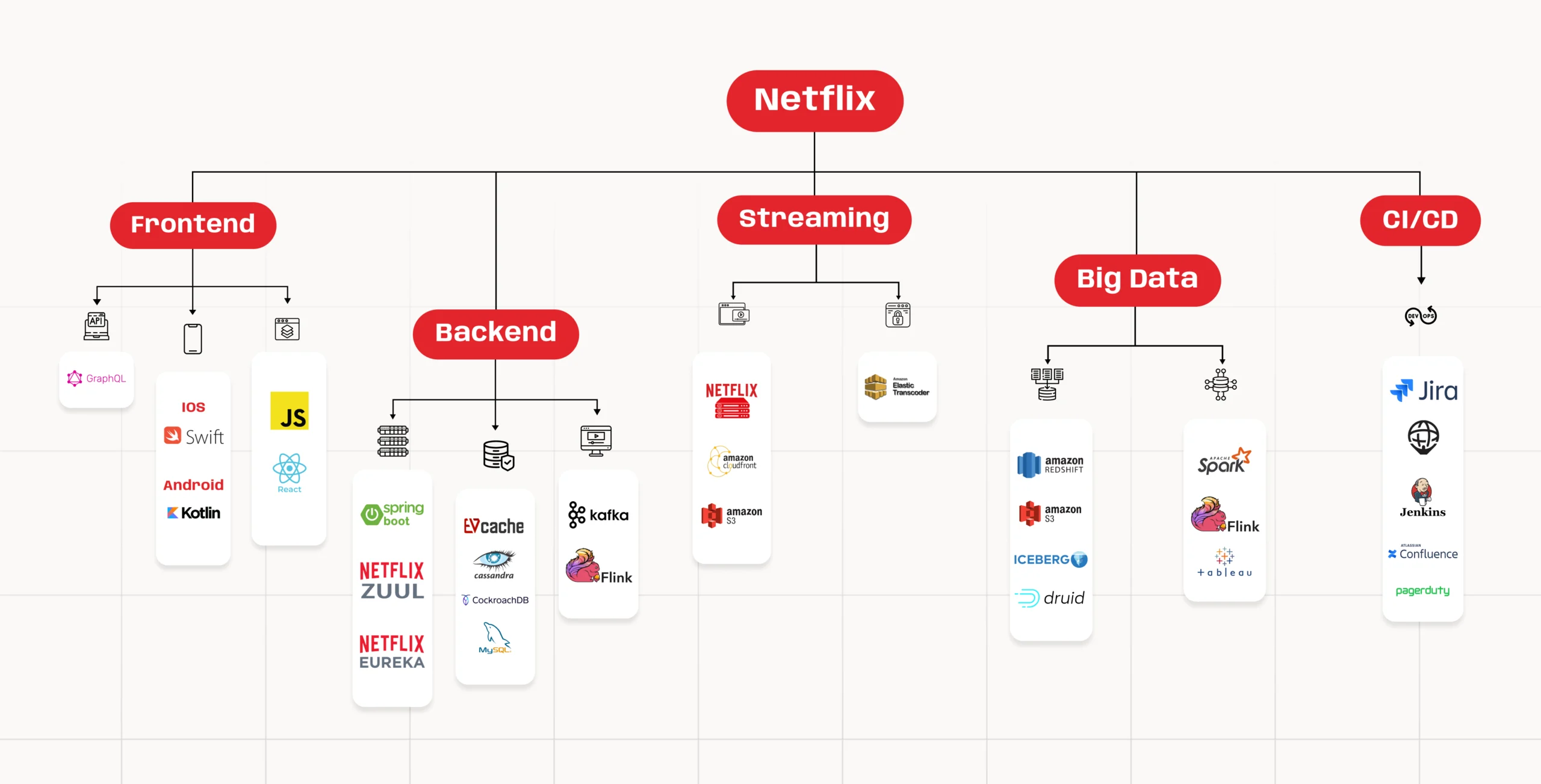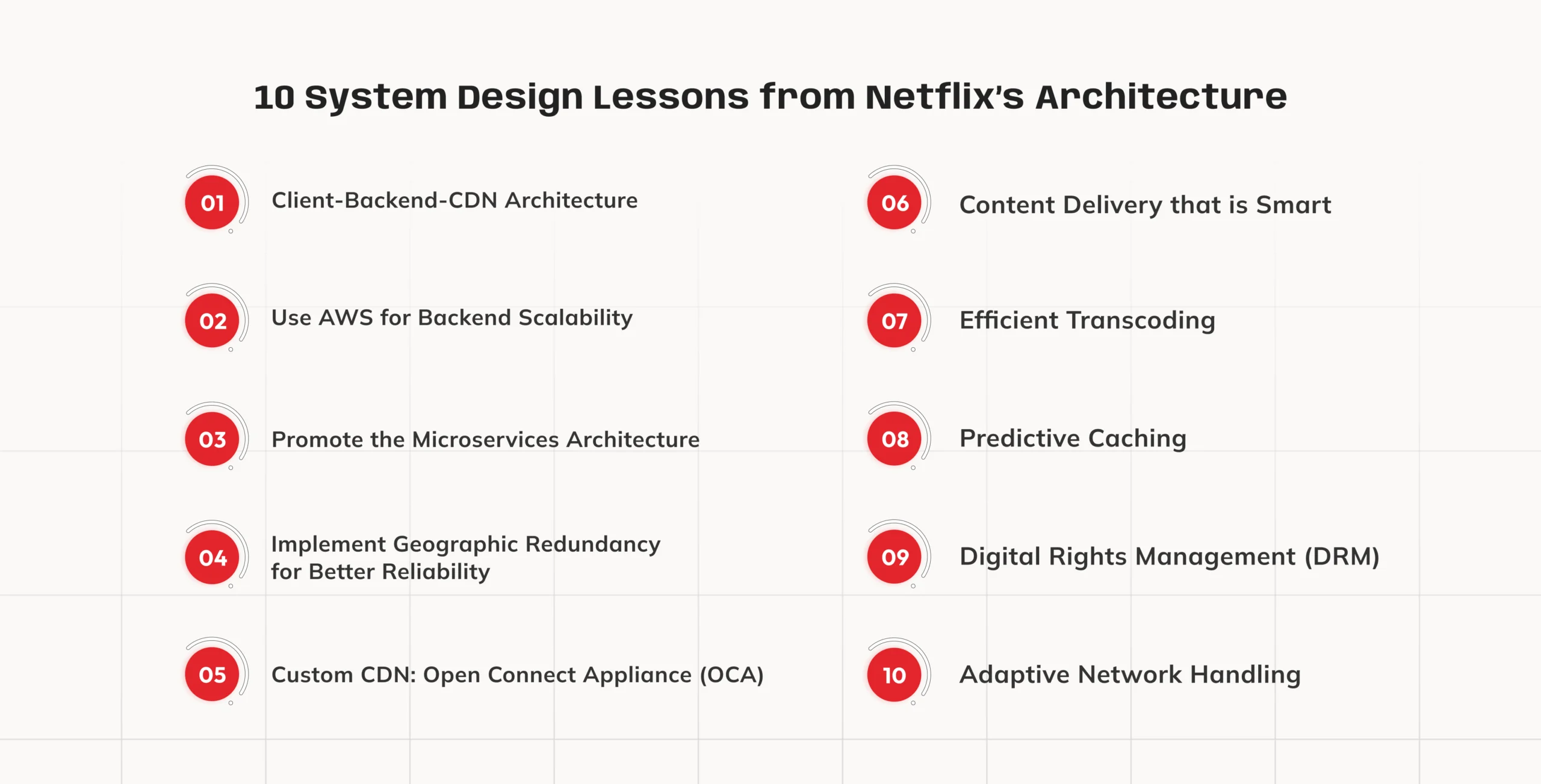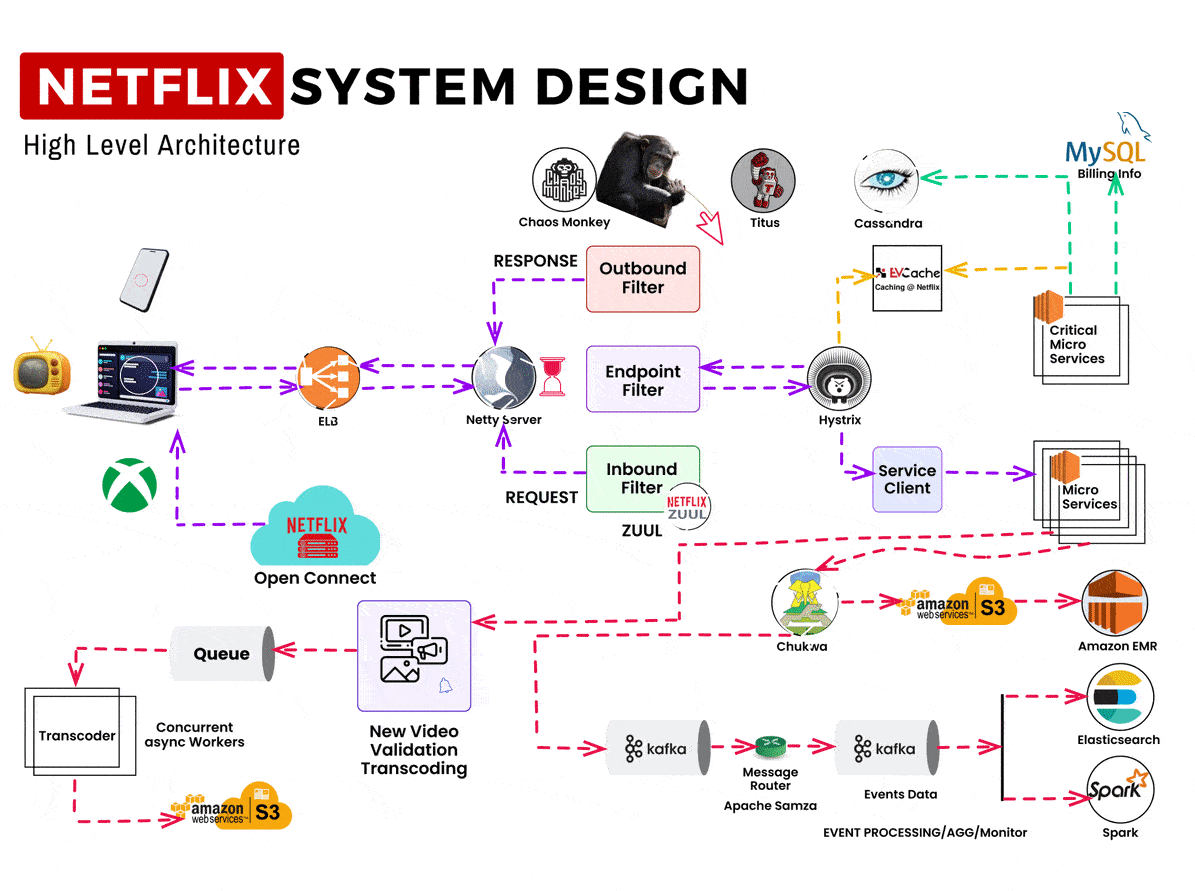Engagement Module
Next Gen AI Solution
Maintenance
Designing
Consultant
Industries
10 Things You Can Learn from Netflix’s Architecture

The introduction of system design in interviews by major tech firms has forced every one of them to go into the study of how those systems are built and it is a good thing because that is the best teacher – looking at actual working systems like Netflix.
The recent Microsoft and Crowtstrike global outages that occurred last month. This issue also affected over 9 million devices and provided difficulty on how globe-trotting works nowadays where an upgrade can create thousands of flight delays affecting millions of people. With millions of its subscribers, Netflix boasts of an amazing system architecture that enables double-dipping of viewing pleasure through its streaming services.
But how is that possible? William Baker dares respond to the opposition. His persuasive skills helped explain not just the product but the business of Netflix in the context of how it actually works. We had spent a tremendous amount of my leisure investigating how to conduct that objection hence this article. This essay, however, will note, that understanding the impulse behind the architecture of systems like these, is crucial when one is preparing for a System design interview.
Apart from preparing common System design questions like API Gateway vs load balancer, Forward Proxy vs Reverse Proxy as well common System Design problems, it makes sense to learn about how big tech is solving system design problems. However, if you’re pursuing System design interviews and need more understanding of System Design, don’t hesitate to look for Sites like ByteByteGo, Design Guru, Exponent, Educative, Codemia.io, and Udemy since they have lots of nice System design courses. It is also very beneficial to know different Architecture patterns like Peer to Peer Patterns, and API Gateway because such systems are capable of enduring failures in production.
How to learn about Netflix Architecture?

we’ve been researching the Netflix architecture for the last three weeks, and after a rough page of secondary material, my first source was YouTube. Numerous Netflix architecture videos caught my eye which we will additionally share in this article together with the lessons we obtained.
The first video we viewed explored how to build a Netflix application which comes from Exponent, one of my beloved channels when getting ready for a System Design Interview.
We found this video helpful in explaining the issue and the resolution we had before exploring solutions to these issues provided by Netflix.
Yes, watching this particular one would be the superior way to start over if you want to learn from limiting architecture else you will find yourself tackling those software design problems which you will most probably fail due to your limited knowledge, but it’s also like mooring the deck for better learning.
The next video we watch is about the Evolution of Netflix API architecture video from BytBytGo, one of the channels that we enjoy YouTube and provides good content for System design.
This video demonstrated the growth of Netflix API architecture from Monolith, Direct Access, and Gateway Aggregation Layer to the current stage of development – Federated Gateway.
Surely, most of these words will feel awkward since they are very high-tech but basically, these things are just scale problem solvers. You better view the clip to get familiarized with them. The third video we watched is about the application of Microservices in Netflix, this time from InfoQ’s YouTube channel, which is also a reputable technology-based channel. Another intriguing video about the architecture of Netflix depicted how the company manages to serve millions of customers spread all over the world. We also find Netflix TechBlog interesting as it is one of the best blogs written about system design from the software engineering point of view. With all this information, we understood a bit of how the architecture of Netflix works, and we have a few things to learn and share with you in this post.
10 System Design Lessons from Netflix’s Architecture

There are ten system design lessons for architects of systems, which Netflix possesses and has an understanding of how difficult it is to build such working, scalable and efficient systems.
1. Client-Backend-CDN Architecture
Netflix’s infrastructure has three main blocks: the client, the server, and the content delivery network.
A client may be a mobile application, a web browser, or an app on a smart television.
The back end resides on AWS and works to personalize content and process payments.
Stock Apple devices would be the Content Delivery Network (CDN) which customly is called the Netflix Open Connect Appliance (OCA) to store and send available videos to the users.
2. Use AWS for Backend Scalability
The company i.e. Netflix runs also the above-mentioned back-end services via AWS and thus benefits from cloud elasticity, which means that the company is allowed to add more server units during the peak periods and reduce the number during the low periods.
The major advantage of this is that there are no reservations and users pay for what they consume.
Lesson: AWS and such similar others provide the required seamlessness and flexibility for workloads to be distributed efficiently at any given time.
3. Promote the Microservices Architecture
Netflix has approximately 700 microservices in operation and uses a variety of databases including DynamoDB and Cassandra. It is this microservices design that facilitates modularity, maintainability, and separate scaling.
Lesson: Microservices architecture provides better scalability, better fault tolerance and faster time to market.
By the way, in case you are eager to know what technology stack is deployed by Netflix, Niubpon has put it in a diagrammatic form which explains the technology stack of Netflix.
4. Implement Geographic Redundancy for Better Reliability
The company has also deployed multiple backend services in different availability zones and AWS geographies, improving both the uptime percentage and fault tolerance capabilities of the system.
This is critical to make sure that a power outage or natural calamity rendering one of the AWS datacenter useless will not bring down the service of Netflix.
Lesson: Geographical redundancy is an effective mechanism for improving system reliability and decreasing the effects of regional failure.
5. Custom CDN: Open Connect Appliance (OCA)
Netflix’s Original Content Architecture (OCA) makes use of standard technology, specifically off-the-shelf computer hardware, that can be able to handle high-capacity network systems. OCAs are established within the local area network of service providers aimed at associating them closer to the users to lower the latency and enhance the quality of streaming.
Lesson: Tailored-made custom CDNs that fit certain specifications can do much better than the generic ones that offer little or moderate interventions.
6. Smart Content Delivery
Upon requesting a video with the push of a button the Netflix application connects the user to an OCA that is closest in distance and network performance to the user, in order to facilitate streaming. In the case of congestion or failure of the network, other OCAs reassign themselves automatically.
Lesson: Network-based intelligent content delivery systems improve user satisfaction and reliability.
7. Efficient Transcoding
Considering that Netflix is compatible with over 2,200 devices, which all use different types of video formats.
All the video contents are transcoded in different dimensions and broken down into small pieces for adaptive bitrate streaming whereby the adjustment of the video quality is dependent on the network conditions.
Lesson: Transcoding fatigue and adaptive bitrate implementation enable the provision of service with the utmost quality regardless of the device used or the network available
8. Predictive Caching
Netflix guesses the videos that a user is most likely to watch and stores them in the OCAs during non-peak times to save bandwidth and enhance the playback.
Lesson: The user experience may be enhanced through the application of predictive caching strategies which help to save loading time and loading costs as well.
9. Digital Rights Management (DRM)
Every video file that is uploaded to Netflix has a DRM functionality added to it to control access to the content and safeguard it from any risks of illegal distribution of the same.
Lesson: This is how you exercise the royalty rights over the content and adhere to the licensing terms for the content acquired.
10. Adaptive Network Handling
Netflix’s backend will return the 10 best OCAs based on the user’s IP. The client will then test the network connection and choose one of the OCAs for streaming.
Lesson: Adaptive network handling and intelligent server selection contribute to the performance and resilience of streaming.

Best System Design Interviews Resources
Also, we have filtered out the top suggestions for system design books, free and paid online system design interview courses and websites for practice, which you can go through to prepare for system design interviews in a better way. Most of these courses address the queries we have posted here, too.
- DesignGuru’s Grokking System Design Course: A learning environment with practical activities and real-life situations for best enhancing one’s system design capability.
- Codemia.io: This is another great platform to practice System design problems for interviews. It has more than 120+ System design problems, many of which are free and it also has a proper structure to solve them.
- “System Design Interview” by Alex Xu: This book takes a closer look into the system design approaches and provides useful tips for mastering rigorous interview processes.
- “Designing Data-Intensive Applications” by Martin Kleppmann: Help would be extensive and focused on the guidelines and techniques of building dependable and elastic systems.
- System Design Tag of LeetCode: LeetCode is among the most widely used websites in practice for technical job interviews. The System Design tag in LeetCode has several questions to work on.
- System Design Primer” on GitHub: It contains useful links to articles books and videos that help in preparation for system design interviews.
- Educative’s System Design Course: It is a learning platform that involves practical sessions alongside the actual situations to improve the system design capability of the learner.
- High Scalability Blog: A blog where articles and research work on the architecture of high-traffic websites and scalable systems are featured.
- YouTube Channels: Channels such as “Gaurav Sen, Tech Dummies” offer useful videos on system design concepts preparing for interviews.
- ByteByteGo: Alex Xu presents a course and book on Strategy Design for System design interview X. It includes everything from volumes I and II of the System Design Interview book series, and will soon add volume 3.
- Exponent: This is a focused platform meant for giving interview coaching, especially for companies in the MAANG group Amazon, Google etc. They have also a wonderful course in system design and other materials which can assist in passing FAANG interviews.
Furthermore, theoretical knowledge must be balanced with its practical application through the implementation of real-life projects and undertaking mock interview sessions. Practice and learning will, of course, augment your skills in system design interviews.
Conclusion
This is everything there is to say about the System Design lessons from the architecture of Netflix. The architecture of Netflix serves well to demonstrate an intelligent system design which is capable of dealing with enormous scale and providing a great end-user experience at the same time.
Balancing load across several geographically distributed data centres using cloud-based microservices architecture, and deploying intelligent CDN and dynamic content delivery approach, enables Netflix to be fast, dependable and extensible.
These lessons learned from the architecture of Netflix are helpful to anyone who intends to design and expand well-performing systems.
You may also refer to the YouTube video that I’ve posted for additional information and a better understanding of Netflix’s architecture. This article was helpful. Please share it with anyone else who is doing system design.
With respect to teams contemplating implementing the same architecture and its associated tools, many such as Braincuber provide great levels of automation, monitoring, and optimization.
Using Braincuber to implement your architecture system, may provide relevant information and management assistance on its testing, deployment, and monitoring process allowing allowances for the adoption of techniques such as autoscaling, fault tolerance and chaos engineering among others easily.



